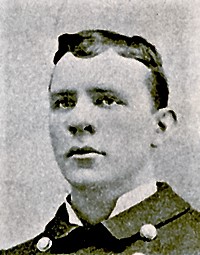Patrolman Henry H. Hanakas | Cincinnati Police Department

Age: 47
Served: 23½ years
October 24, 1894 to March 3, 1918
OFFICER
Henry Hennekes was born January 7, 1871 in Cincinnati to grocer, George B. Hennekes, and Nettie Hennekes. His parents, aunts, and uncles immigrated from Germany between 1846 and 1857. Henry legally changed his name to Hanakas before 1894 for reasons that are lost to history and family lore.
Henry’s Uncle Herman Henry Hennekes started a family tradition when he joined the Cincinnati Police Department during 1880. Another uncle, John Anthony Hennekes, joined as well. On October 8, 1894, Henry was nominated for appointment as Substitute Patrolman on the Cincinnati Police Department joined the Cincinnati Police Department on October 9, 1894. Then, his cousin, Edward H. Hennekes, joined. Edward also served as a Hamilton County Deputy Sheriff and then Secret Service Agent. A third uncle, Harry Hennekes, became a Workhouse Guard in 1905.
Henry was tested for promotion April 20, 1895 and scored 100%. He took the oath of office for Patrolman on May 15, 1895. For many years, he was assigned to “the bottoms”, the toughest beat in the City. By 1918, he was working out of the 7th District in Walnut hills.
During 1897, he married Katherine L. Friesz (19). By 1918, they had six surviving children (one died in 1907), five of whom lived with them at 1708 Hanfield and one who was serving in the United States Navy. His wife was pregnant with their 8th child.
INCIDENT
On February 28, 1918, Patrolman Hanakas responded to a report of family trouble at 1227 Whitlow Street. A recent transplant from Alabama, Samuel “Vanny” Pitts (25), of that address, hid behind the door as the officer entered and he attacked Patrolman Hanakas from behind. Pitts took the officer’s sidearm and the two struggled over it, during which the revolver discharged five times; one round entering Patrolman Hanakas’s jaw and exiting through his neck. Pitts then began pistol whipping Patrolman Hanakas about the head and Patrolman Hanakas was able to strike Pitts on the head with his nightstick causing a deep laceration. Pitts escaped through a kitchen window.
Other officers responded and Patrolman Hanakas was taken to Cincinnati General Hospital with what were not considered to be life-threatening injuries.
DEATH
Patrolman Hanakas’s brain swelled and four days later, on March 3, 1918, he died.
Patrolman Hanakas was survived by his wife of 21 years, Katherine L. Hanakas; children, George B. Hennekes, Margaret H. Hennekes, Anna Hennekes, Charles “Harry” Hennekes, John “Jack” Hennekes, and James Hennekes; and other relatives including his uncle, Cincinnati Patrolman Harry Hennekes (Retired). Funeral services were held at St. Boniface Church and he was buried on March 6, 1918, in St. Mary’s Cemetery, St. Bernard.
INVESTIGATION
Immediately following the murder, Chief Copelan ordered a massive manhunt for Pitts, but he had vanished. Chief Copelan then issued “wanted” bulletins throughout the country, especially in the South.
On March 3, 1918, after the officer’s death, Coroner Bauer heard evidence and examined the remains and determined that Patrolman Hanakas had died primarily due to a concussion of his brain caused by a blow to his head with his revolver.
On April 2, 1918, Waverly Hall (GA) Town Marshal J. R. Langford found Pitts working on a cotton plantation, arrested him, and interrogated him. Pitts confessed to the killing, claiming self-defense. On April 5, the State of Ohio issued to the State of Georgia a requisition for Pitts. Cincinnati Detective Samuel Daulton took a train to Georgia, picked Pitts up and arrived with him back in Cincinnati on April 8, 1918 and charged him with Murder.
On June 29, 1918, Pitts’s Murder case was ignored by the Grand Jury for the ridiculous reason that “the [bullet] wound was not deemed sufficient to have caused death.”
EPILOGUE
Neither the violence done to Patrolman Hanakas, nor the injustice in his murderer’s release were sufficient to deter his grandson, Robert Hennekes, from continuing the tradition and, after serving time in the United States Marine Corps, becoming a Cincinnati Police Officer. Late in his career, Detective Hennekes was also shot in the line of duty. While jogging off duty and unarmed, he interceded in a bank holdup and was shot in the chest. He nearly died, but survived, later retired, and, among other activities, traveled to Iraq early in the 21st Century to train Iraqi police officers.
If you know of any information, artifacts, archives, or images regarding this officer or incident, please contact the Greater Cincinnati Police Museum at Memorial@Police-Museum.org.
© This narrative was researched and revised on March 1, 2018 by Cincinnati Police Lieutenant Stephen R. Kramer (Retired), Greater Cincinnati Police Museum Executive Director, with research assistance from Cincinnati Homicide Detective Edward W. Zieverink III (Retired), Greater Cincinnati Police Museum Historian, and genealogical research conducted by Greater Cincinnati Airport Police Chief Thomas Mentrup (Retired), Greater Cincinnati Police Museum Volunteer. All rights are reserved to them and the Greater Cincinnati Police Museum.